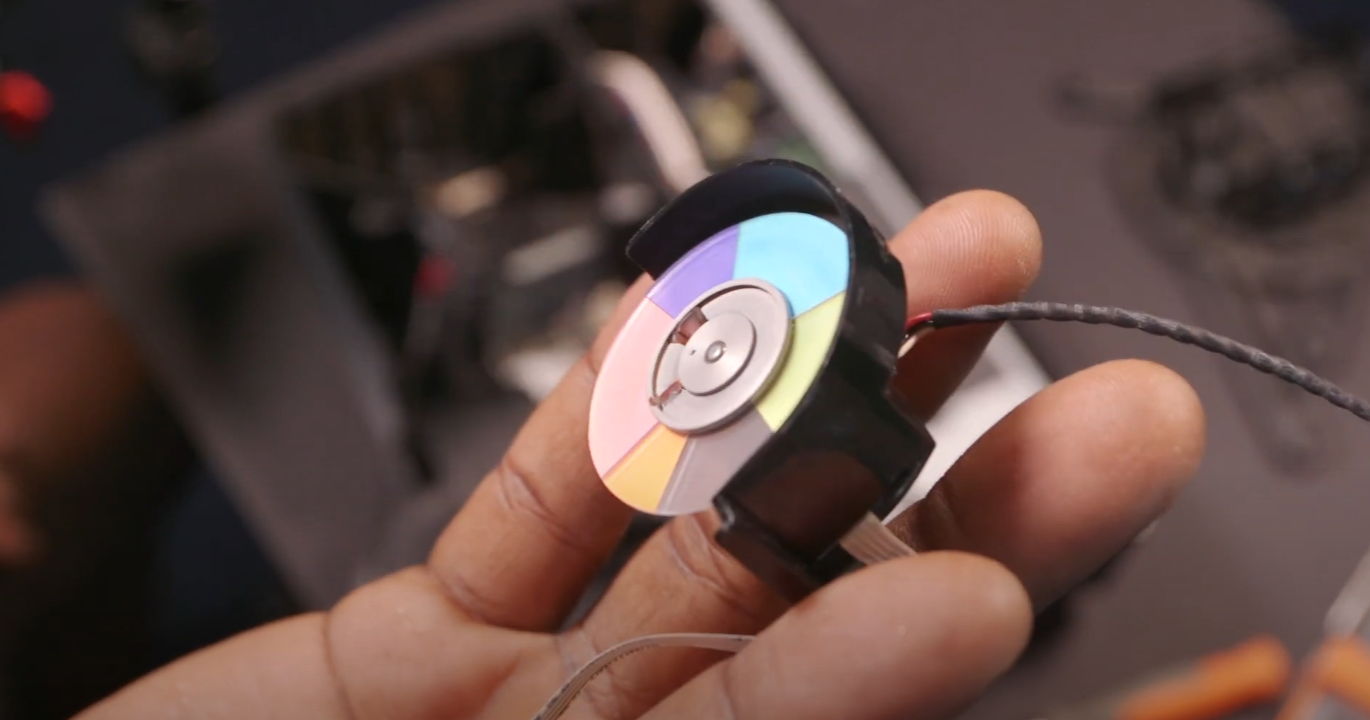What is a Projector Color Wheel

Imagine stepping into a movie theater, the lights dimming, and a beam of light cutting through the darkness to project stunning visuals on the big screen. Have you ever wondered how projectors create such vivid and lifelike colors? The answer lies in a small but essential component known as the projector color wheel. In this blog post, we'll delve into the world of projectors and explore the intricacies of the color wheel, uncovering the magic that brings your favorite movies, presentations, and events to life.
As we embark on this journey, we'll unravel the purpose and functionality of the projector color wheel. We'll demystify its role in separating and reproducing the primary colors of light, leading to a vast array of hues and shades. We'll also discuss the advantages and potential limitations of projectors with color wheels, including the infamous "rainbow effect." By the end of this post, you'll gain a deeper understanding of how the color wheel shapes your visual experience and why it is a crucial consideration when choosing a projector.
So, join us as we dive into the fascinating world of projectors and unravel the secrets of the color wheel. Are you ready to discover how this tiny, spinning wonder enhances your viewing pleasure and adds vibrancy to your projections? Let's begin our exploration together!
In short: Projector color wheel is a rotating disc found within projectors that is composed of different colored segments. It plays a crucial role in separating white light emitted by the projector's lamp into primary colors, such as red, green, and blue. As the color wheel spins, the projector's light source passes through the color segments, creating an illusion of various colors and shades. The color wheel is essential for achieving accurate and vibrant color reproduction in projected images and videos. By understanding the projector color wheel, we can appreciate its contribution to the immersive visual experiences provided by projectors in home theaters, classrooms, and other professional settings.
- What Exactly is a Projector Color Wheel
- Pros and Cons of Projectors With a Color Wheel
- FAQ About Projector Color Wheel
What Exactly is a Projector Color Wheel
The color wheel is a crucial component found in many projectors that helps create and display colors accurately. Here's a breakdown of what a projector color wheel is and how it works:
-
Definition: The projector color wheel is a rotating disc that consists of different colored segments. It is typically located between the light source and the projection lens.
-
Purpose: The color wheel's main purpose is to separate white light emitted by the projector's lamp into its primary colors: red, green, and blue (RGB). By doing so, it enables the projector to display a wide range of colors by manipulating the timing and intensity of these primary colors.
-
Color Segments: The color wheel is divided into segments, each coated with a specific color filter—usually red, green, blue, and sometimes additional colors like yellow or cyan. These segments are arranged in a specific order, such as RGBRGB or RGBCMY, depending on the projector's design.
-
Rotational Speed: The color wheel spins at a high speed, typically several thousand revolutions per minute (RPM). This rotation is synchronized with the projector's imaging system to ensure that the correct colors are displayed at the right time.
-
Color Mixing: As the color wheel spins, the projector's light source passes through the color segments. By combining the primary colors in various proportions and timings, the color wheel creates the illusion of different colors, shades, and hues.
-
DLP Technology: The color wheel is particularly common in projectors that use Digital Light Processing (DLP) technology. DLP projectors use tiny mirrors to reflect light, and the color wheel controls which color of light is reflected by each mirror.
Understanding the projector color wheel and its role in color reproduction is essential, as it directly affects the image quality and color accuracy of the projected content. By using the correct color filters and precise timing, the color wheel enables projectors to produce vibrant and realistic visuals.
Different Types of Projectors That Commonly Use a Color Wheel
| Projector Type | Description |
|---|---|
| DLP (Digital Light Processing) | DLP projectors utilize a color wheel along with tiny mirrors to reflect light and create images. |
| LCD (Liquid Crystal Display) | LCD projectors use liquid crystal panels to control light and produce images. Some LCD projectors also incorporate a color wheel. |
| LCoS (Liquid Crystal on Silicon) | LCoS projectors utilize liquid crystal technology on a silicon chip to control light and create images. Some LCoS projectors may have a color wheel. |
Please note that not all projectors within a specific technology category will include a color wheel. It's important to check the specifications of individual projector models to determine if they incorporate a color wheel or not.
When choosing a projector, consider factors such as color accuracy, contrast ratio, motion handling, and personal preferences to ensure it aligns with your specific needs and desired viewing experience.
Pros and Cons of Projectors With a Color Wheel
Pros:
- Wide Color Range: Projectors with a color wheel can offer a wide color gamut, allowing for vibrant and accurate color reproduction.
- Cost-Effective: Projectors with color wheels tend to be more affordable compared to other advanced color reproduction technologies.
- Established Technology: Color wheels have been used in projectors for a long time, making them a reliable and well-established technology in the industry.
- Suitable for Various Applications: Projectors with color wheels are suitable for a wide range of applications, including home theater setups, classrooms, and business presentations.
Cons:
- Rainbow Effect: One of the main drawbacks of color wheel projectors is the potential occurrence of the "rainbow effect." This effect can cause brief flashes of rainbow-like artifacts, particularly noticeable to some viewers during fast-moving scenes or when shifting focus.
- Limited Color Accuracy: While color wheels provide a wide range of colors, they may struggle to reproduce certain shades accurately, especially in the areas where colors overlap.
- Lower Color Saturation: Projectors with color wheels may have limitations in reproducing highly saturated colors, resulting in less vivid color representation.
- Mechanical Component: The color wheel in projectors is a mechanical component that can be prone to wear and tear over time, requiring maintenance or replacement.
It's important to note that the pros and cons listed above are specific to projectors with color wheels. The choice of projector technology depends on individual preferences, budget, and the desired application. It's advisable to consider factors such as viewing environment, intended content, and personal preferences when selecting a projector.
FAQ About Projector Color Wheel
What is a projector color wheel?
A projector color wheel is a rotating disc within a projector that is made up of segments in different colors. It is responsible for separating white light into its primary colors and producing the desired color output for projected images.
How does a projector color wheel work?
When the projector lamp emits white light, it passes through the color wheel. As the wheel spins, the colored segments filter the light, allowing only specific colors to reach the projection surface. By adjusting the speed and timing of the color wheel rotation, the projector creates the illusion of a full range of colors.
What are the primary colors used in a projector color wheel?
The most common primary colors used in projector color wheels are red, green, and blue (RGB). These three colors are combined in varying intensities to create a wide spectrum of colors and shades.
Can I replace the color wheel in a projector?
In most cases, the color wheel in a projector is not user-replaceable and requires professional service or manufacturer assistance for replacement. It is a delicate component that is precisely calibrated to work with the projector's optics and synchronization.
What is the "rainbow effect" associated with projector color wheels?
The "rainbow effect" refers to brief flashes of rainbow-like artifacts that some viewers may perceive, particularly in fast-moving scenes or when shifting focus. It can occur in single-chip DLP projectors due to the sequential color presentation caused by the spinning color wheel.
Are there projectors without a color wheel?
Yes, there are projector technologies that do not require a color wheel. For example, some LCD and LCoS projectors use other methods, such as three separate LCD panels or reflective mirrors, to control and modulate colors.
Does the size or design of the color wheel affect projector performance?
Yes, the size and design of the color wheel can impact projector performance. Factors such as the number of color segments, their arrangement, and the rotation speed can affect color accuracy, brightness, and the potential for the rainbow effect.
Can I adjust the color wheel speed or settings on a projector?
Projector color wheel settings, including speed and synchronization, are typically optimized and set by the manufacturer. They are not user-adjustable in most consumer-grade projectors.
